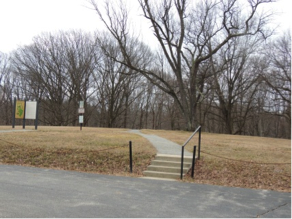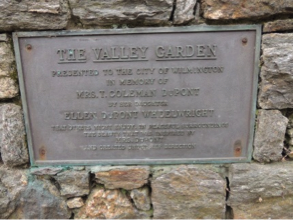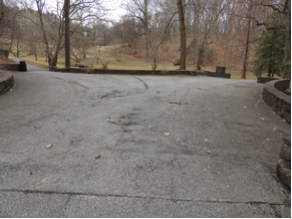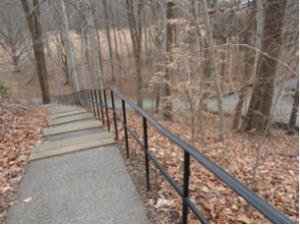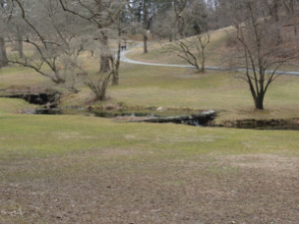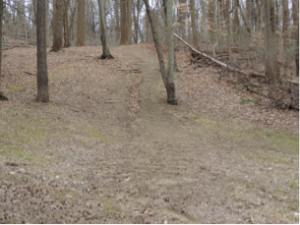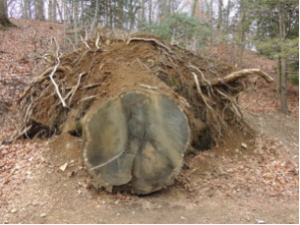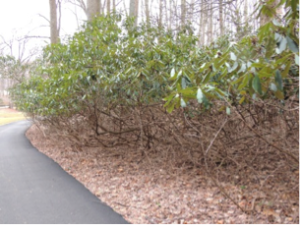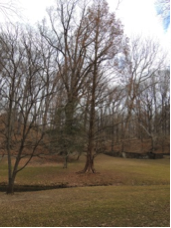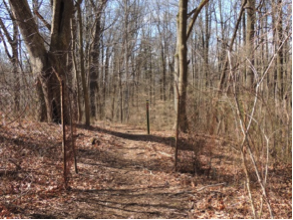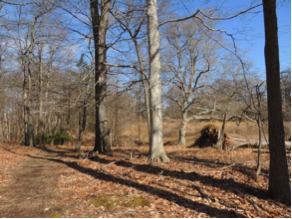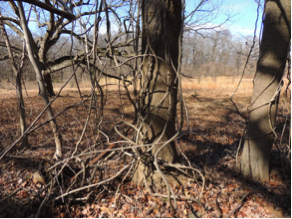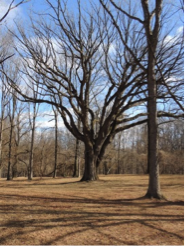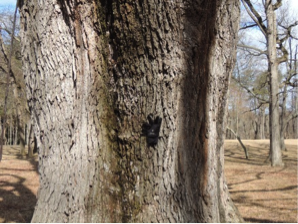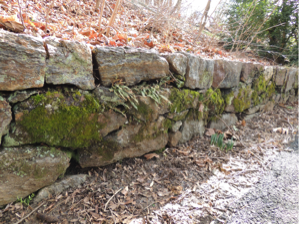Where: Campbell Road, just off Route 52, Wilmington, Delaware 19807
 The name Valley Garden Park perfectly captures the setting of this small park, beautifully landscaped and well maintained. According to a plaque in the park, it was donated to the City of Wilmington by DuPont Wheelwright in memory of her mother, Mrs. T. Coleman DuPont, whose brainchild it was.
The name Valley Garden Park perfectly captures the setting of this small park, beautifully landscaped and well maintained. According to a plaque in the park, it was donated to the City of Wilmington by DuPont Wheelwright in memory of her mother, Mrs. T. Coleman DuPont, whose brainchild it was.
To get to the park, take Route 52 South into Delaware, past Winterthur Gardens, and make a right on Campbell Road. The park entrance is about a half mile on, on the left. If you overshoot, you will drive over the causeway over the Hoopes’ Reservoir. The parking is at the entrance. To the back of the lot is an information station with a map of the park, and a short way beyond is a nice view over the lower level of the park, which is reached by a steep wooden stairway down; alternately use the ramp to the lower level on the left as you enter the parking spaces. Either way, you will arrive at the valley level of the park. Since the park is small detailed distances are unnecessary. Please follow all posted signs.
An attractive entrance court makes a good place to stop and take your bearings. The path that goes off to the right and makes a 1-mile loop of the park and returns on the left – feel free to go in either direction. Here, I will describe the clockwise path around the path. A few yards ahead is a small stair on the right leading up to another viewpoint. I surmise that the proliferation of viewpoints means that the park’s original owners spent a lot of time here enjoying it, and that is rather a satisfying thought. Additionally, a nice smattering of benches allows everyone to sit down and soak in the peace. Going on, the road turns left over a small bridge; the path on the right leads to a restricted area. This is the lower end of the park, but as you walk back up the valley, you will see lots of trails leading up the rhododendron-fringed hillsides – explore them at your leisure.
The path then passes up past a millstone and a cross-section of a massive tree that once stood here – I counted 200 rings, although I didn’t see anything to indicate when it fell. To the left stands a massive American sycamore tree with its white branches towering over the park. This makes a fine landmark for orienting yourself anywhere in the park – it is highly visible. There are nice views up the valley, with some lovely trees dotting the grass and the stream flowing neatly down the length of the park. Further up, the road curves back to the entrance, but a small spur road leads off to the right. At the junction is another map and you can now better appreciate the network of little trails that you saw leading off the main path The spur winds to a large meadow which is a perfect spot for a picnic.
It’s the return journey that holds the magic for me. Walk back along the spur road and turn right on to the main path. A short while later, the path passes over the culvert, and to its left is a trail up the hillside. This trail hugs the tree line, which is dotted with winged elm, and winds about a quarter mile to an opening in a fence through which you can reach the Hobbs Trail (a part of the State Park system). This trail is simply gorgeous (given that I am partial to wild places). The beech and oak trees are unkempt with grapevines festooning everything. The path leads down, past a hollowed out tree, over a small wooden bridge fringed with bamboo.
At this point you can turn left or right. The path on the right (Hobbs Cut-off; about 0.4 miles) drops down past lots of Queen Anne’s lace plants to a marshy spot with ostrich fern dotting the ground, up the hill and around a clump of mountain laurel, holly and rose bushes, past a field, and eventually returns to Valley Garden Park.
If you choose to turn left instead, the enormous fallen tree just off the path is a nice spot to stop and take in the view: a small clearing with grass to the right and a massive and perfectly proportioned oak in the center of the field ahead. Just past this point, paths come off the central path to right and left. The left path goes half-way around the field along the fence line and abruptly stops. You can turn around or push your way through rather bristly low growth in the field, returning to the starting point. The path to the right is the return leg of the path ahead. Take the path ahead which turns mossy and cool, and then emerges on to a sunny, grassy field. Loop the grassy field, keeping it always to your right. There are other small trails that emerge from here but they are short – explore them at your leisure. The path loops back to through woods to the fallen tree that you passed earlier. Along this trail notice the abundance of grape vine hanging from the tulip poplars and a tall grass (which I cannot identify). Then the path loops around to the right around the grass field and returns to the start through a lovely stretch of woodland. The path is up on the valley side of the hill and has pleasant views down to the ostrich-fern encrusted valley (which the Hobbs Cut-off crosses higher up).
On the left on your way back to main trail from Hobbs Trail, or directly ahead if you are coming from Hobbs Cut-off, you will pass a Penn’s Oak. Penn’s Oaks are massive oaks whose girth gives a measure of their age. The Nature’s Notes below briefly explains dendrochronology – the science of interpreting tree rings. My glove placed on the trunk in the photo provides scale to gauge the immensity of this tree. Pass on, past the younger, thinner trunked trees sprinkling the slope. After you get to the main trail, you will pass a trail going up on the right which takes you up the hill facing the parking-lot hill. If you take this trail, you will pass over a large, sloping grass field here that is quiet and pleasant to walk around. Please do not enter the fenced-off area to the right. To get to the parking lot, walk down the slope and up the wheelchair access road back to the parking lot. Alternately, stay on the main path, pass some stonework with lichen, moss and fern growing on it, and return to the parking lot via the stairs or the access road.
Nature Notes: Dendrochronology
Etymologically speaking, dendron means tree limb, khronos means time, and logos means explanation; dendrochronology is the science of dating events, such as past climate, by examining tree rings. If you have been following my column, an early article dealt with the difference between two fundamental groups of plants: the monocots and the dicots. Most monocots are herbaceous or shrubby with little secondary growth, and thus not useful for dendrochronology as they do not collect the ring patterns of growth year after year. Trees with trunks are either gymnosperms (evergreens) or dicots (most deciduous plants). Thus dendrochronology applies only to gymnosperms and dicots that are fairly long lived.
Valley Garden Park gives you the opportunity to examine the cross-section of a massive, approximately 200-year old, tree. Each tree ring is composed of a light and dark strip indicating the rate of tree growth. The light strip indicates the warmer season when conditions are favorable for rapid growth, and the dark strip indicates slower growth towards the end of the growing season. These layers are made up of xylem and phloem; tissues in the tree that carry either water (xylem) or sap (phloem). Xylem is laid down closer to the center of the tree, and phloem, which carries sweet sap, is on the outside towards the bark. It is the phloem that is tapped in the spring when the growing season takes off to make maple syrup. This sweet sugary sap feeds the roots which, buried underground, cannot make their own food, but still need nutrition to do their job of absorbing minerals and water. Water rises up the tree through xylem tubes linked to one another to make straws in the center. When it stops functioning, xylem becomes heartwood. Sapwood typically refers to xylem and phloem that are still functional and carrying water and dissolved sugars. Each growing season accounts for one ring, and counting back from the time the tree was felled can give scientists a picture of the conditions that the tree encountered. For example, forest fire frequency, long term weather patterns, and disease outbreaks can all be inferred by looking at tree rings.
Finally, it would be a shame if dendrochronology could only be investigated by cutting down a living tree. A living tree’s rings can examined by drilling core samples in a tube that extends to the center of the tree, but doesn’t destroy the rest of the tree, in a fashion similar to drilling core samples in ice. Using this method, the oldest trees in the world have been identified: the bristlecone pines of USA’s west coast, which are still alive today and have been growing for over 4000 years. These ancient beings were already 2000 years old when Jesus was born. That’s food for thought.

